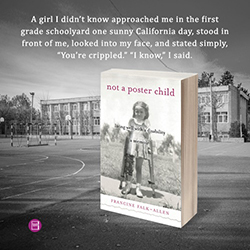
Francine Falk-Allen
By Francine Falk-Allen
As a polio survivor (age three, left with partial paralysis of one leg which did not grow as much as the other leg), all of my life I have had moments when I turned to see a child trying to imitate my walk. It was always disconcerting, and of late, just a little surprising, as when you realize toilet paper is stuck to your shoe and trailing along behind. When I matured, I could smile at the pantomime, and think, “Do I really walk like that??!” And those occasions have given me many opportunities to tell children the reason I walk like this, even when their parents were grabbing their arms and telling them, “Stop it! That girl (or woman) is crippled!”
That is actually always worse for me than what the kid is doing. Sometimes the mom apologizes with embarrassment (always a tinge of “sorry you are disabled”) and sometimes she just scurries her kid away, too embarrassed to look at me. It’s actually more painful to hear someone say, “That woman is crippled” than it is to see a child imitate me. Maybe it’s the third person referral. I prefer the eye contact moms, because then I can say, “It’s OK. Happens all the time with children. Don’t worry about it.”

Falk-Allen is author of the book Not a Poster Child: Living Well with a Disability
I used to tell little kids I had a disease “when I was about your age, that caused my leg not to grow.” I’d do this especially if they asked (which mothers will often try to stifle, but, I think it’s healthy for a child to show curiosity about differences). Eventually, I realized that my explanation scared small children, to think that they could get a disease that would deform them as it had me. So, I simplified my explanation to “One of my legs is shorter than the other.” If the why’s ensued and we came to my having polio, I’d say, “But you won’t get polio, because you have had your vaccinations. They didn’t have vaccinations when I was a little girl.” They can talk to their moms about vaccinations if they have not had them.
I’m walking along a sidewalk downtown somewhere and see my reflection, stunned to see that I am limping badly. And I want to just ignore it, though many others cannot. If I am alarmed to see it, and I have lived with it most of my life, what must go through their heads? What went through the head of the middle-aged man in an expensive sports car (and haircut) who stared at my polio foot that one day, without looking at my face, while I walked into the library? While I was waiting for eye contact? I felt like an anomaly, an object, not a human, when he did that.
We are all human and curious. We all have feelings, and we all make mistakes.
What works for me and most handicapped people is for passersby to make eye contact and give a friendly hello. Most of us are fine about being approached respectfully and especially about meeting a curious child. One mother of a child in a wheelchair says she wants children to say hello and exchange names first, so that her son will know the child considers him a peer with interests, and not just interesting because he is abnormal.
Fortunately, we do have the opportunity to eradicate polio. You can start by having friends and relatives support Rotary’s efforts as my husband and I do!
Francine Falk-Allen is author of Not a Poster Child: Living Well with a Disability – a Memoir, She Writes Press, 2018. She and her husband contribute annually to Rotary’s PolioPlus fund.
https://blog.rotary.org/2018/09/25/how-does-it-look-when-i-walk/
